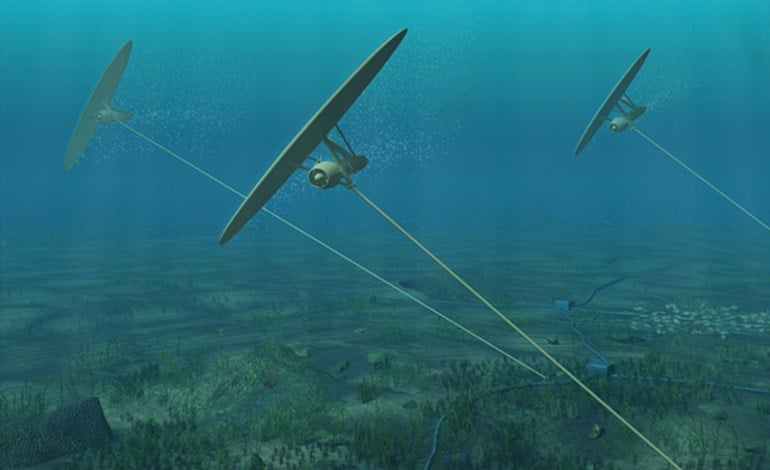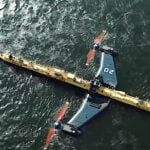In 2018, Minesto, the marine energy technology development company operating out of Gothenburg, Sweden, signed an agreement with the main power supplier of the Faroe Islands that is paving the way for green energy generation.
Minesto’s Deep Green subsea kite technology may be the next breakthrough for generating green energy. SEV, the Faroe Island’s main power generator and supplier, installed 2 of Minesto’s DG100 model subsea kites that generate electricity which goes directly into the Faroe Island’s power grid [1].
The DG100 works similarly to a stunt kite flying in the wind. As the kite experiences the movement of underwater tidal flows, its wings generate hydrodynamic lift, moving the system through the water. This underwater movement is controlled by a series of rudders and an onboard control system that moves the kite in a figure 8 pattern. By moving in a figure 8, the underwater kite is able to generate speeds several times faster than the water current, forcing water through the kite’s system and over a turbine to produce electricity.

The figure 8 trajectory of the DG100 has a 40m width and a height of 17m, so it’s best located in areas where the water depth is approximately 50m. Each Deep Green device has a wingspan of 5 meters, a power rating of 100kW, and can operate in stream flows of 1.2-2.5m/s.
This approach to sustainable energy, which is nearing the end of its trial stages in the Faroe Islands, is revolutionary when compared to other sources of green energy. The reliability of the tides means that energy production is predictable, unlike wind or solar, and each DG100 device is essentially portable without involving invasive installation procedures that alter the environment, since each device only needs to be tethered to the sea floor using an anchor.
The installation of Minesto’s DG100s coincides with the Faroe Islands announcing that they plan on generating 100% of their power from renewable energy by 2030 [2].
In June 2019, the European Commission’s SME Instrument Program awarded Minesto a €2.5 million grant to fund the Faroe Island’s DG100 installation. Referred to as the Deep Green Island Mode (DGIM) project, the installations in the Faroe Islands will act as a testing ground for developing commercial viability of their products as well as building commercial ties with European utility companies.
With approximately 15 million Europeans living on Europe’s 2,400 islands, energy production systems such as the DG100 have the potential to replace outdated and inefficient energy sources that leave island communities dependent on outside sources. Other conventional tidal energy systems are also often unsuitable for many of these communities since conventional systems require a tidal flow greater than 2.5m/s, a speed that is uncommon for most coastal areas around the world.

In talking about Minesto’s relationship with SEV and the Faroe Islands, Minesto CEO Dr. Martin Edlund said “SEV is an advanced customer with a pioneering energy transition agenda and a world-class tidal energy resource. With Minesto’s technology, they can add a predictable and affordable source of clean energy with the potential to play a significant role in Faroes Islands’ transition to 100 percent renewable energy by 2030”.
Since 2018, Minesto has set up additional testing operations in Strangford Lough in Ireland, and in Hollyhead Deep off the coast of Wales where other DG models are being developed and tested [3].
Notes
- Source: ‘An archipelago in the Atlantic is using kite-like tech to produce electricity from tidal power’, CNBC
- Source: ‘Faroe Islands – tidal energy to reach 100% renewable by 2030’, Minesto
- Source: ‘Project and technology development’, Minesto
































